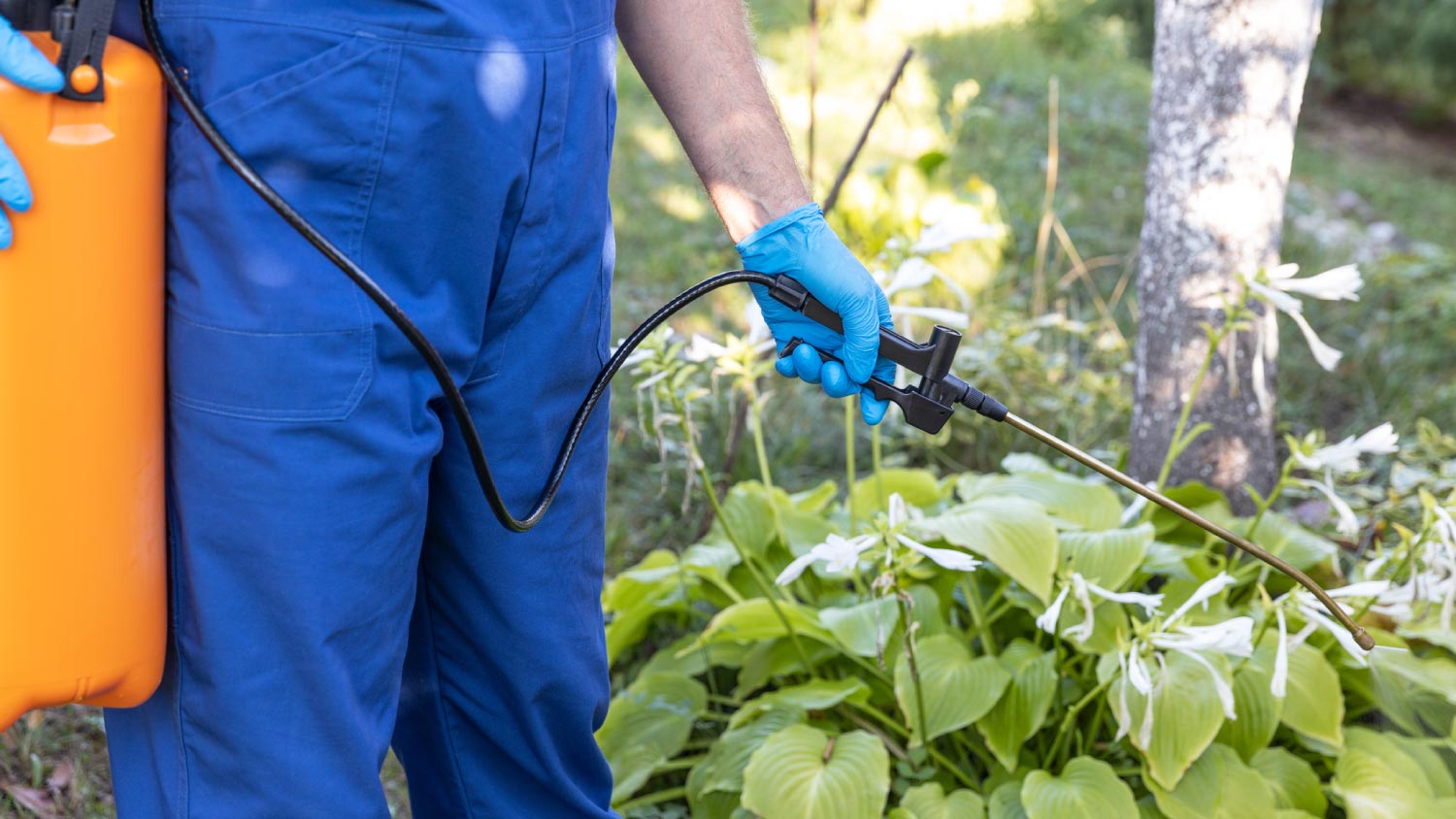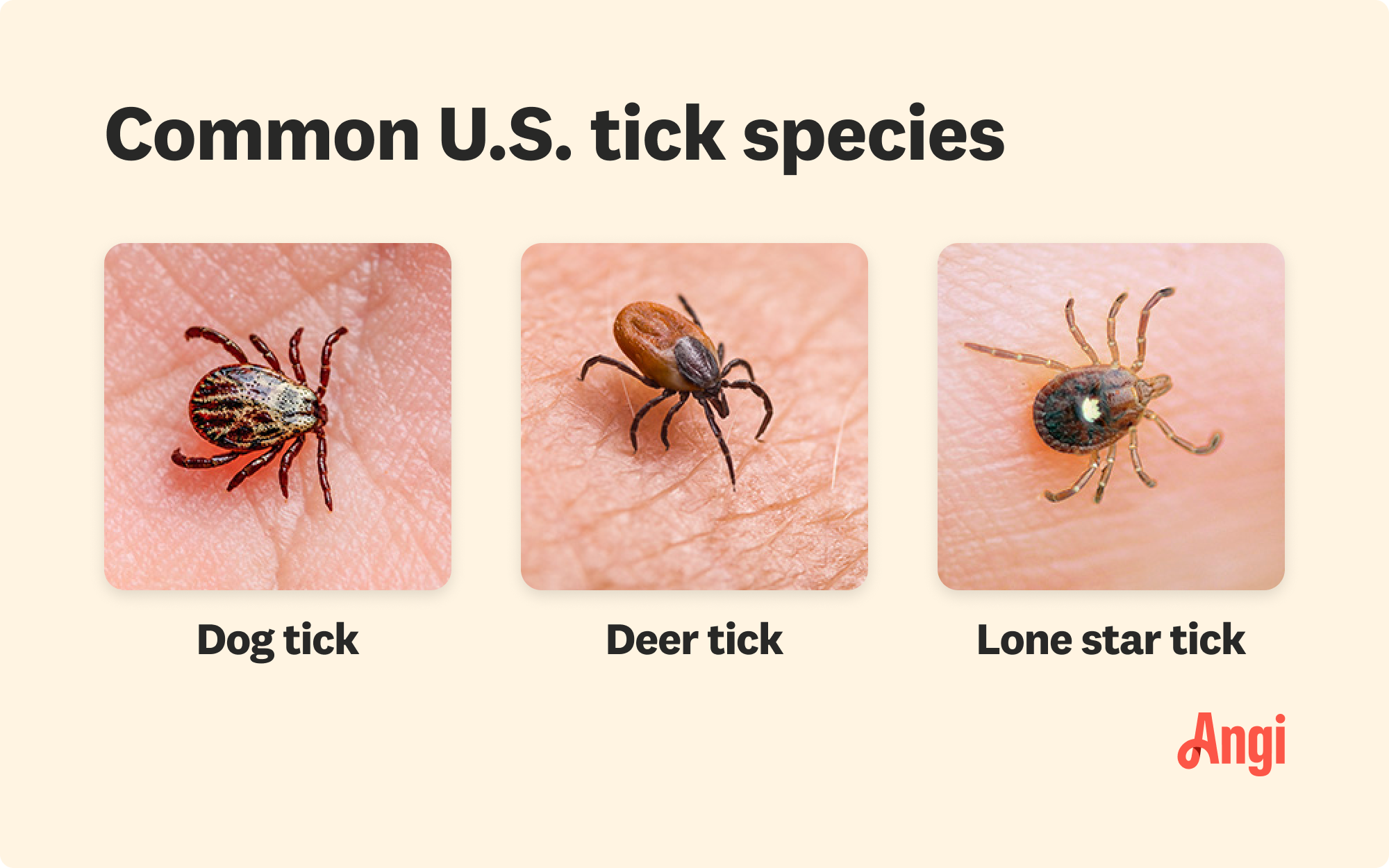
Termite damage repair costs can vary greatly based on the damage severity and location. Learn more about the associated costs of this project with our guide.
Treating a property for ticks costs around $125 on average, depending on the yard size. Most homeowners spend between $50 and $150.


The lowest cost of tick extermination is $40, while larger infestations can cost up to $1,250 to fully eliminate.
You can expect to pay $0.08 to $0.15 per square foot for tick treatment.
Tick treatment costs vary by number of treatments required, ranging from mild (1–3 visits) to severe (7–8 visits).
Due to the chemicals required to eliminate ticks from your home, you must hire a pest control professional to ensure they’re implemented safely and correctly.
A one-time indoor and outdoor treatment for tick extermination costs $125 on average and includes an inspection, diagnosis, and treatment. Costs can range from $50 to $150 depending on infestation size. Expect to pay $0.08 to $0.15 per square foot of property being treated.
Ticks carry pathogens that can cause a host of diseases in people and animals, so if you live in an area with lots of ticks or have a known tick infestation, professional tick prevention and treatment services are crucial.

Several factors affect tick treatment costs, including the size and landscape of the treatment area and infestation severity.
Tick treatments are priced by square foot or acre because larger areas require more chemicals than smaller areas. Therefore, the larger your treatment area, the more you can expect to pay.
The severity of the tick infestation often dictates how many treatments you'll need, and more treatments will increase your total costs. For instance, mild tick infestations might only require one treatment, while very severe infestations can require eight or more.
Areas with lots of hiding places for ticks, such as high grass, mulch beds, and wooded areas, typically cost more to treat than flat areas without lots of trees or other hiding spots. That's because these areas often have more ticks, requiring more time and chemicals to treat.
Tick treatment costs heavily depend on the square footage of the treatment area. You can expect to pay $0.08 to $0.15 per square foot for tick treatment.
Larger areas require more chemicals to treat, driving up the total cost. For example, a 2,000-square-foot area typically costs $160 to $300 to treat, while a 3,000-square-foot area costs $240 to $450. Keep in mind that indoor treatments usually cost more than outdoor treatments due to the additional chemical precautions.
Some people choose to treat a large outdoor property for ticks. In this case, many companies charge by the acre rather than by square foot. Tick treatment typically costs $100 to $300 per acre.
| Acreage | Average Cost |
|---|---|
| ½ | $70–$150 |
| 1 | $100–$300 |
| 2 | $200–$400 |
| 3 | $300–$500 |
| 4 | $400–$600 |
Often when you find one tick, it means others are lurking nearby. If you have a very severe infestation of pesky crawlers, you'll likely need more than one treatment. In fact, very severe infestations might require as many as seven or eight treatments.
| Infestation Severity | Number of Treatments | Average Cost |
|---|---|---|
| Mild | 1 | $50–$150 |
| Moderate | 3–4 | $200–$600 |
| Severe | 7–8 | $400–$1,200 |
The most obvious sign of a home tick infestation is spotting a tick attached to you, a family member, or a pet. Ticks attach themselves to people and animals to feed on blood. They do this by embedding their heads inside of skin, leaving the rest of their bodies exposed. Another sign of tick infestation is the development of flu-like symptoms in members of a household.
Before you take any action to deal with a tick infestation, be sure to correctly identify the pest you’re dealing with as ticks and not fleas or bed bugs, both of which have similar environments and feeding habits. Ticks are wingless, flat-bodied parasites. All species are less than half an inch long with eight legs. There are three common types of tick to look out for in the U.S.:
Dog ticks: Reddish-brown, mostly found in northern states
Deer ticks: Black or dark brown legs, active in spring and fall, and mostly found in the Midwest
Lone star ticks: Caramel-colored with a yellow "star" on the back (if female), found in the Northeast and Southeast
Ticks are commonly found around pet crates, upholstered furniture, and a home's entryways. You can also find them in your yard, where they commonly lurk near retaining walls, dense brush, tall grass, forested areas, yard debris, and areas where your pets tend to lounge. It's easiest to spot them when using a flashlight.

DIY tick treatment sprays aren’t always effective, especially if they’re not applied in the correct areas. They can also pose serious health risks to children and pets if they’re not used strictly following the manufacturer's guidelines. Hiring a local exterminator ensures safe, effective treatment without the added risks.
Ticks are resilient pests that require strong chemical treatments and precise application. Here’s why hiring a pro is the safest bet:
Professionals use commercial-grade products that kill ticks at all life stages without harming your family or pets.
Pest control experts identify where ticks are nesting and apply the right treatment method for your yard or home.
Pros follow EPA regulations and know how to avoid overexposure to harmful pesticides.
Many companies offer ongoing tick prevention plans to keep your home and yard protected year-round.
Here are a few options for DIY tick removal tasks:
Purchase tick treatment spray, averaging $20 to $35 per gallon, rated for your specific yard or surface type.
Mow grass regularly, clear leaf piles, and remove brush to limit tick habitats.
Use pet-safe tick repellents to prevent tick bites on your pets.
The best way to save money on tick extermination costs is to take preventative measures to avoid having to exterminate them in the future.
Address the issue quickly: Time is of the essence (and budget) when it comes to ticks. The longer you wait to hire a tick exterminator after finding one in your home, the bigger the infestation gets, making it more expensive to eradicate.
Treat your yard annually: If your yard has a reputation for being a popular spot for ticks, it’s worth investing in annual yard treatments to avoid the additional cost and hassle of treating ticks that move inside your home.
Check for ticks regularly: Performing frequent tick checks on pets, kids, and adults can help catch infestations early and eradicate them before they begin hosting in your home. Nipping a tick infestation in the bud can save you money on more extensive tick extermination services.
Your home and its exterior are the most common locations to find pests. Ticks are much less likely to be found indoors, however, and most fall into the 6.6% of pest infestations that occur in the yard or outdoor space.
Request details from your exterminator on the type of pesticide they plan to use and whether it's safe to use around pets and children.
Discuss preventative treatment options for long-term tick control, including annual inspections.
Confirm whether your pro offers bundled pest services or ongoing maintenance discounts.
Home is the most important place on earth, which is why Angi has helped more than 150 million homeowners transform their houses into homes they adore. To help homeowners with their next project, Angi provides readers with the most accurate cost data and upholds strict editorial standards. We extensively research project costs to develop the pricing data you see, so you can make the best decisions for you and your home. We rely on reputable sources, including the U.S. Bureau of Labor Statistics, academic journals, market studies, and interviews with industry experts—all to ensure our prices reflect real-world projects.
Want to help us improve our cost data? Send us a recent project quote to [email protected]. Quotes and personal information will not be shared publicly.
From average costs to expert advice, get all the answers you need to get your job done.

Termite damage repair costs can vary greatly based on the damage severity and location. Learn more about the associated costs of this project with our guide.

Whether you have bugs, bats, or rodents invading your home, you’ll want to contact an exterminator quickly. Find out how much pest control costs in Columbus, OH.

Your mosquito misting system cost will vary based on factors such as the size, type, brand, and more. Find out what the budget for this system looks like.

Discover methods for how to get rid of rabbits using humane tactics, including fences, repellents, and a decoy garden. Get ready to send those bunnies hopping.

Mice are unsettling intruders in your vehicle that have the potential to cause major damage over time. Learn how to keep mice out of your car.

Find your best option for removing bed bugs in our comprehensive guide. Learn how to get rid of bed bugs and how to stop them coming back.